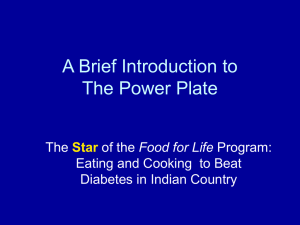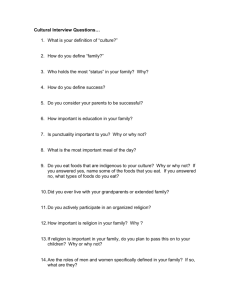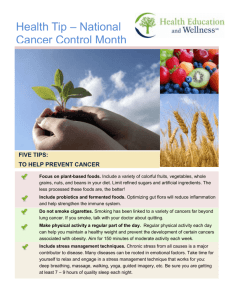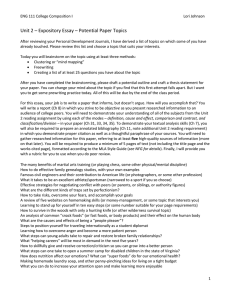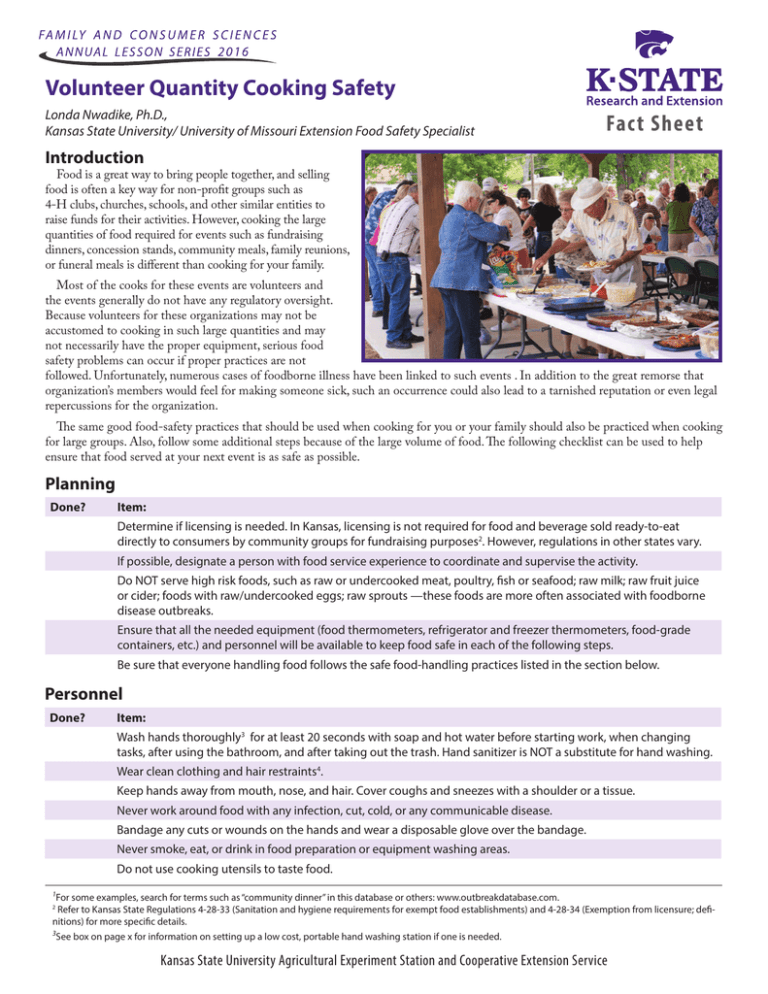
Volunteer Quantity Cooking Safety
Londa Nwadike, Ph.D.,
Kansas State University/ University of Missouri Extension Food Safety Specialist
Fact Sheet
Introduction
Food is a great way to bring people together, and selling
food is often a key way for non-profit groups such as
4-H clubs, churches, schools, and other similar entities to
raise funds for their activities. However, cooking the large
quantities of food required for events such as fundraising
dinners, concession stands, community meals, family reunions,
or funeral meals is different than cooking for your family.
Most of the cooks for these events are volunteers and
the events generally do not have any regulatory oversight.
Because volunteers for these organizations may not be
accustomed to cooking in such large quantities and may
not necessarily have the proper equipment, serious food
safety problems can occur if proper practices are not
followed. Unfortunately, numerous cases of foodborne illness have been linked to such events . In addition to the great remorse that
organization’s members would feel for making someone sick, such an occurrence could also lead to a tarnished reputation or even legal
repercussions for the organization.
The same good food-safety practices that should be used when cooking for you or your family should also be practiced when cooking
for large groups. Also, follow some additional steps because of the large volume of food. The following checklist can be used to help
ensure that food served at your next event is as safe as possible.
Planning
Done?
Item:
Determine if licensing is needed. In Kansas, licensing is not required for food and beverage sold ready-to-eat
directly to consumers by community groups for fundraising purposes2. However, regulations in other states vary.
If possible, designate a person with food service experience to coordinate and supervise the activity.
Do NOT serve high risk foods, such as raw or undercooked meat, poultry, fish or seafood; raw milk; raw fruit juice
or cider; foods with raw/undercooked eggs; raw sprouts —these foods are more often associated with foodborne
disease outbreaks.
Ensure that all the needed equipment (food thermometers, refrigerator and freezer thermometers, food-grade
containers, etc.) and personnel will be available to keep food safe in each of the following steps.
Be sure that everyone handling food follows the safe food-handling practices listed in the section below.
Personnel
Done?
Item:
Wash hands thoroughly3 for at least 20 seconds with soap and hot water before starting work, when changing
tasks, after using the bathroom, and after taking out the trash. Hand sanitizer is NOT a substitute for hand washing.
Wear clean clothing and hair restraints4.
Keep hands away from mouth, nose, and hair. Cover coughs and sneezes with a shoulder or a tissue.
Never work around food with any infection, cut, cold, or any communicable disease.
Bandage any cuts or wounds on the hands and wear a disposable glove over the bandage.
Never smoke, eat, or drink in food preparation or equipment washing areas.
Do not use cooking utensils to taste food.
1
For some examples, search for terms such as “community dinner” in this database or others: www.outbreakdatabase.com.
Refer to Kansas State Regulations 4-28-33 (Sanitation and hygiene requirements for exempt food establishments) and 4-28-34 (Exemption from licensure; definitions) for more specific details.
3
See box on page x for information on setting up a low cost, portable hand washing station if one is needed.
2
Kansas State University Agricultural Experiment Station and Cooperative Extension Service
Shopping
Done?
Item:
Acquire food from safe sources. For example, buy from reputable suppliers; ensure that any home-grown produce
you use is raised using safe food-growing practices5.
Separate raw meats from ready-to-eat products in the cart and in your grocery bags. For example, place raw meat
on the bottom rack of the cart with ready-to-eat food in the top of the cart.
When bagging groceries, separate raw meat from ready-to-eat foods.
Plan shopping so that perishable foods6 will not be in the temperature danger zone of 40ºF to 140ºF for more than
2 hours (1 hour if outside temperature is >90ºF)7. If needed, bring enough coolers with ice packs or ice along to
keep products cool in transit.
Storing
Done?
Item:
Ensure you have enough storage space for the larger quantities of food purchased, particularly refrigerated storage
for perishable foods.
Clean all storage areas, including refrigerator, freezer, and dry goods storage.
Don’t overfill your refrigerator so that cold air circulates properly.
Use a refrigerator thermometer to ensure the temperature stays below 40ºF.
Store refrigerated food in the proper arrangement: poultry on the bottom, with ground meats above that,
followed by whole muscle meat cuts, and ready-to-eat foods, such as lettuce, tomatoes, and cheeses on top
Use a freezer thermometer to ensure the freezer temperature stays below 0ºF. Ensure the freezer is not too full for
the door to close properly.
Do NOT store non-perishable foods such as canned goods directly on the floor; rather, store them on a wire rack or
somewhere that is easily cleanable and is less likely to be in contact with insects or rodents.
Use only food-grade containers for storing food to ensure no microbial or chemical contamination. Do not use
garbage cans, garbage bags or similar containers not meant for holding foods.
Preparing food
Done?
Item: Chill
Thaw meat in the refrigerator, in cold water (that is changed regularly), in the microwave, or as part of the cooking
process. Do NOT thaw meat at room temperature or in the sink in hot water.
After cooking, ensure that the internal product temperature gets to <40ºF within four hours of cooking. To achieve
this, you could:
• put large containers of hot food into an ice bath in your sink,
• stir the food to transfer out heat to help it cool faster, and/or
• put large quantities of food into smaller quantities or shallower pans.
Put cooked food in the refrigerator within 2 hours of cooking.
Done?
Item:
Cook: Use a tip-sensitive, accurate food thermometer8 to ensure that foods reach a safe internal product
temperature to kill harmful microorganisms9. See table on page x for a list of safe temperatures.
Clean: Clean and sanitize10 all equipment used to prepare and handle food.
Separate: Do not use the same utensils or equipment (cutting boards, plates, utensils, etc.) for raw and ready-to-eat
foods unless they are washed and sanitized.
In situations where it may be difficult for food handlers to wear clean clothes (such as 4-H fair concession stands), it is very important to provide clean cloth
aprons or disposable plastic aprons, and clean visors or hats for workers to use.
5
More information on fresh produce safety, particularly for School and Community Gardens, is available from: www.ksre.ksu.edu/bookstore/pubs/MF3152.pdf
6
Perishable foods are those that require time and temperature control for safety because they support rapid and progressive growth of pathogenic microorganisms or toxin formation. Examples include: meats, poultry, fish, and shellfish; milk and milk products; shell eggs; cooked rice, pasta, beans, and vegetables
including baked potatoes; cut fruits and vegetables; raw seed sprouts; cream pies.
7
Microorganisms can double every 20 minutes when in the temperature danger zone, so it is important that perishable foods are not in this zone for long periods
of time.
8
Stem food thermometers and refrigerator thermometers can be purchased for less than $10 at most grocery stores and hardware stores. Be sure that the stem
food thermometer can be calibrated and check its calibration occasionally. More information on calibrating thermometers is available on p. 9 of publication
MF3138: www.ksre.ksu.edu/bookstore/pubs/MF3138.pdf
4
2
K-State Research and Extension — Volunteer Quantity Cooking Safety
Transporting prepared food
Done?
Item:
Keep hot food hot (>140ºF) and cold food cold (<40ºF) when transporting. Wrap hot food in blankets or use an
insulated cooler as needed to maintain temperature.
Do not allow perishable foods to be in the temperature danger zone (40ºF-140ºF) for more than 2 hours.
Transport food in clean vehicle compartments. Cover food to protect it from potential sources of contamination,
such as family pets or children.
Serving food
Done?
Item:
If reheating food, ensure the internal food temperature reaches 165ºF within two hours. This will require food to
be re-heated in a microwave, on the stove top or in the oven. (Slow cookers or candle warmers cannot achieve this
high of a temperature).
Hot foods must be held at 140ºF or warmer during serving. Use a food thermometer to check internal product
temperature in the center or thickest part at least once an hour. Electric roasters, slow cookers, and adequate
candle warmers may be able to achieve this temperature, but the temperature must be checked.
Cold foods must be held at 40ºF or colder.
Keep hot foods covered as much as possible.
Ensure that everyone handling food washes their hands properly, including before serving food.
Even if wearing gloves for serving foods, servers still need to wash their hands properly11. Hand sanitizer and/or
gloves are not a substitute for hand washing.
It is preferable to allow no bare hand contact with ready-to-eat foods. Servers should instead use spoons, tongs,
deli paper, or gloves to handle food.
If guests serve themselves, they should get a new plate each time they return to the serving line, rather than
reusing a soiled plate.
Cleaning up
Done?
Item:
Thoroughly wash and sanitize countertops and utensils, particularly after handling raw meat. The sanitizing
solution should be freshly made at least daily or every 3 to 4 hours for longer events, using 1 teaspoon bleach in 1
gallon potable water.
Clean and sanitize customer tables in the eating area, if possible after each use.
Commercial dishwashers, if available, are the best option for cleaning tableware. If using a sink, clean the sink first
to remove any germs or residue. Scrape, soak or rinse leftover food from the dirty dishes; then wash, rinse, sanitize
(see text box below for more details) and let air dry12.
Steps for cleaning and sanitizing in a three-compartment sink
Step
Where
Details
Wash
1 sink
Clean detergent solution in >110ºF water. Use brush or cloth to loosen soil
Rinse
2 sink
Clean potable water (>110ºF). Remove all traces of food and detergent so sanitizer will be more
effective
Sanitize
3rd sink
Immerse items in hot water (>170ºF) for 30 seconds or in a chemical sanitizing solution for one minute.
Chlorine concentration should be at least 50 parts per million (1 teaspoon bleach per gallon of water).
Follow manufacturer’s directions for other sanitizers such as quaternary ammonia. Note that cloths
used to sanitize countertops and tables after cleaning should be allowed to soak in a solution of the
same concentration.
st
nd
Note that if a three-compartment sink is not available, a dishpan can be used for one or more of the above steps.
9
Note that thermometers must be cleaned and sanitized (wiped with a clean washcloth and with sanitizing solution) between different foods or different containers of the same food to prevent cross-contamination.
10
More information on sanitizing is available in the text box on page x.
11
See box on page x for information on setting up a low cost, portable hand washing station if one is needed.
K-State Research and Extension — Volunteer Quantity Cooking Safety
3
Leftovers
Done?
Item:
Do not reuse foods that have been served, such as put out on a buffet or put on a plate at a table. *One exception
to this is non-potentially hazardous foods still in their original packaging, such as crackers.
Foods that were prepared but not served can be reused if they were held at proper temperatures (<40ºF for cold
foods or >140ºF for hot foods) and cooled properly (internal product temp to <40ºF within four hours)
Reuse prepared but not served food within 1 to 2 days. Do not reuse more than once.
Internal cooking temperatures
Product
Minimum Internal Temperature
All poultry — whole birds, parts, ground products
165ºF
Stuffing (should be cooked outside of bird when served to
large groups)
165ºF
Ground meats (other than poultry)
160ºF
Steaks, roasts, chops(beef, veal, lamb, pork)
145ºF with a 3-minute rest time
Precooked ham (to reheat)
140ºF
Eggs
Cook until yolk and white are firm
Egg dishes (quiche, etc.)
160ºF
Reheating leftovers, casseroles
165ºF
Finfish
145ºF or until flesh is opaque and separates easily with a fork
Shrimp, lobster, crabs, scallops
Cook until flesh is opaque
Clams, oysters, and mussels
Cook until shells open during cooking
Setting up a portable handwashing station
The following components are needed for a portable
handwashing station:
a.
b.
c.
d.
e.
f.
5-gallon cooler modified with a hands-free spigot13
Catch basin for waste-water
Liquid soap
Paper towels
Adequate supply of warm water
Trash receptacle
Next Steps:
Based on the checklist above, develop a list of the top items
that you should work on before the next time you or your
organization will prepare a larger quantity of food than normal:
1. 2. 3. 5 Gallon thermal container
Paper
towels
Soap
Continuous
flow spigot
Trash
receptacle
5 Gallon
discard
bucket
12
Using cloth towels for drying can re-contaminate the dishes, as the towels often get dirty from drying previous dishes, from dirty hands, or touching dirty
objects.
13
Standard 5-gallon coolers can be easily modified to have a free-flow spigot through the following steps: 1) Unscrew the original push button spigot; 2) Install
a hands-free replacement spigot available for bottled water coolers. These are commonly available at hardware and home-brewing stores for less than $8. See
http://pubstorage.sdstate.edu/AgBio_Publications/articles/ExEx14083.pdf for more information on hand washing stations.
Sources for Further Information:
Parties and Large Groups General Information. Foodsafety.gov. Available from: www.foodsafety.gov/keep/events/parties
Cooking for a Crowd. Penn State Extension. 2003. Available from: http://extension.psu.edu/food/safety/educators/cooking-for-crowds
Publications from Kansas State University are available at:
www.ksre.ksu.edu
Publications are reviewed or revised annually by appropriate faculty to reflect
current research and practice. Date shown is that of publication or last revision.
Contents of this publication may be freely reproduced for educational purposes.
All other rights reserved. In each case, credit Londa Nwadike, Volunteer Quantity
Cooking Safety, Fact Sheet, Kansas State University, July 2015.
Kansas State University Agricultural Experiment Station and Cooperative
Extension Service
K-State Research and Extension is an equal opportunity provider and employer.
Issued in furtherance of Cooperative Extension Work, Acts of May 8 and June
30, 1914, as amended. Kansas State University, County Extension Councils,
Extension Districts, and United States Department of Agriculture Cooperating,
John D. Floros, Director.
MF3213 July 2015

